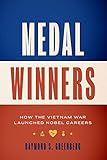Medal Winners : How the Vietnam War Launched Nobel Careers / Raymond S. Greenberg.
Material type: TextPublisher: Austin : University of Texas Press, [2021]Copyright date: ©2020Description: 1 online resource (401 p.)Content type:
TextPublisher: Austin : University of Texas Press, [2021]Copyright date: ©2020Description: 1 online resource (401 p.)Content type: - 9781477319437
- 610.92/2 23
- R153 .G75 2020
- online - DeGruyter
| Item type | Current library | Call number | URL | Status | Notes | Barcode | |
|---|---|---|---|---|---|---|---|
 eBook
eBook
|
Biblioteca "Angelicum" Pont. Univ. S.Tommaso d'Aquino Nuvola online | online - DeGruyter (Browse shelf(Opens below)) | Online access | Not for loan (Accesso limitato) | Accesso per gli utenti autorizzati / Access for authorized users | (dgr)9781477319437 |
Frontmatter -- CONTENTS -- Acknowledgments -- Prologue -- PART I SOLDIERS FOR SCIENCE -- 1 Annus Horribilis -- 2 Best in Class -- 3 “My Son, the Doctor” -- 4 Yellow Berets -- 5 Campus Life -- PART II MENTORS AND APPRENTICES -- 6 NIH’s Finest Hour -- 7 Beginning at Termination -- 8 Following the Right Path -- 9 In Earl’s Court -- 10 Harmony in Hormones -- 11 Priest and Prophet -- 12 Overcoming Repression -- PART III FOUR LAUREATES -- 13 The Texas Two-Step -- 14 Adrenaline Rush -- 15 Infectious Enthusiasm -- Epilogue -- Notes -- Bibliography -- Index
restricted access online access with authorization star
http://purl.org/coar/access_right/c_16ec
As the ground war in Vietnam escalated in the late 1960s, the US government leveraged the so-called doctor draft to secure adequate numbers of medical personnel in the armed forces. Among newly minted physicians’ few alternatives to military service was the Clinical Associate Training Program at the National Institutes of Health. Though only a small percentage of applicants were accepted, the elite program launched an unprecedented number of remarkable scientific careers that would revolutionize medicine at the end of the twentieth century. Medal Winners recounts this overlooked chapter and unforeseen byproduct of the Vietnam War through the lives of four former NIH clinical associates who would go on to become Nobel laureates. Raymond S. Greenberg traces their stories from their pre-NIH years and apprenticeships through their subsequent Nobel Prize–winning work, which transformed treatment of heart disease, cancer, and other diseases. Greenberg shows how the Vietnam draft unintentionally ushered in a golden era of research by bringing talented young physicians under the tutelage of leading scientists and offers a lesson in what it may take to replicate such a towering center of scientific innovation as the NIH in the 1960s and 1970s.
Mode of access: Internet via World Wide Web.
In English.
Description based on online resource; title from PDF title page (publisher's Web site, viewed 27. Jan 2023)


